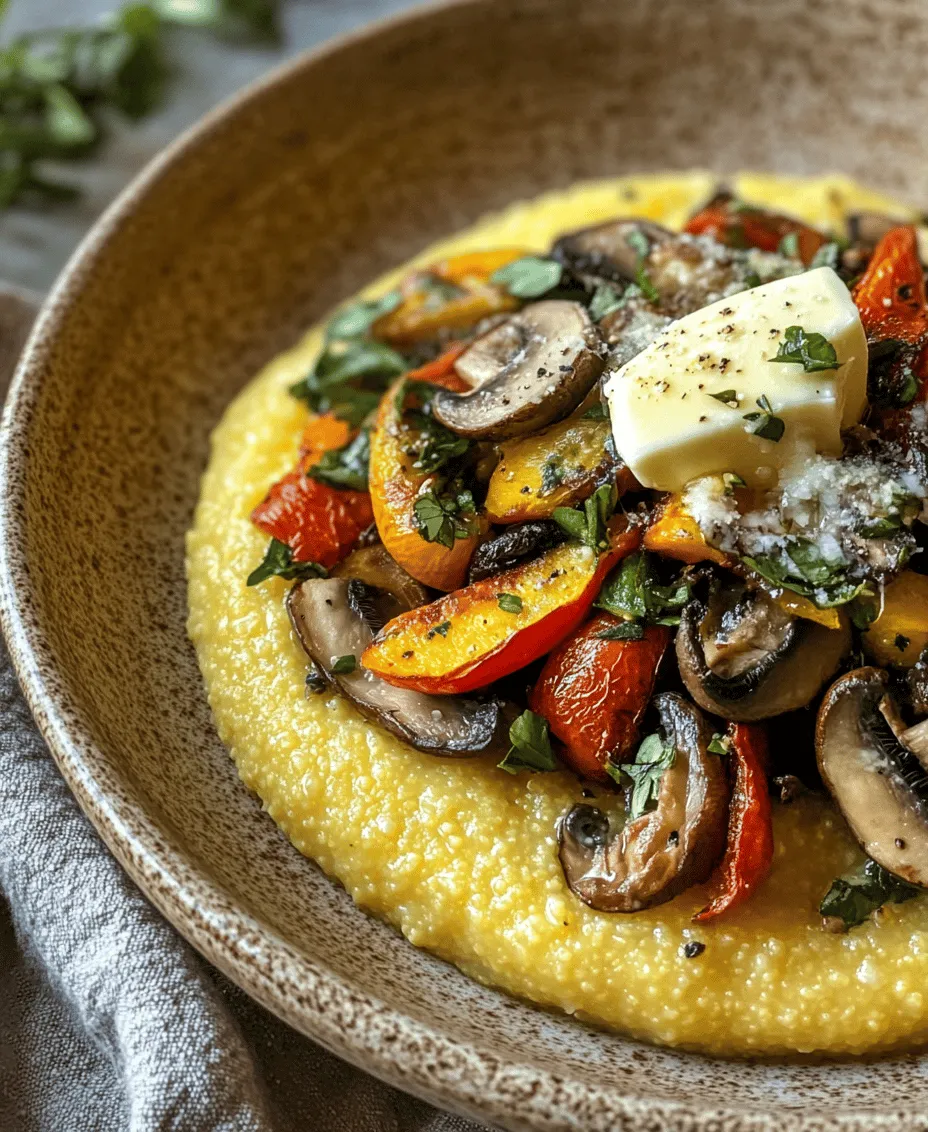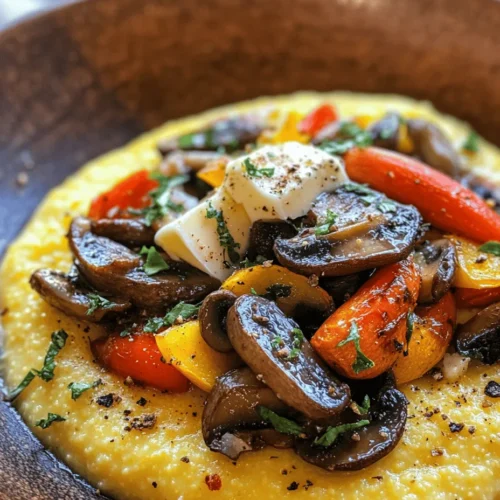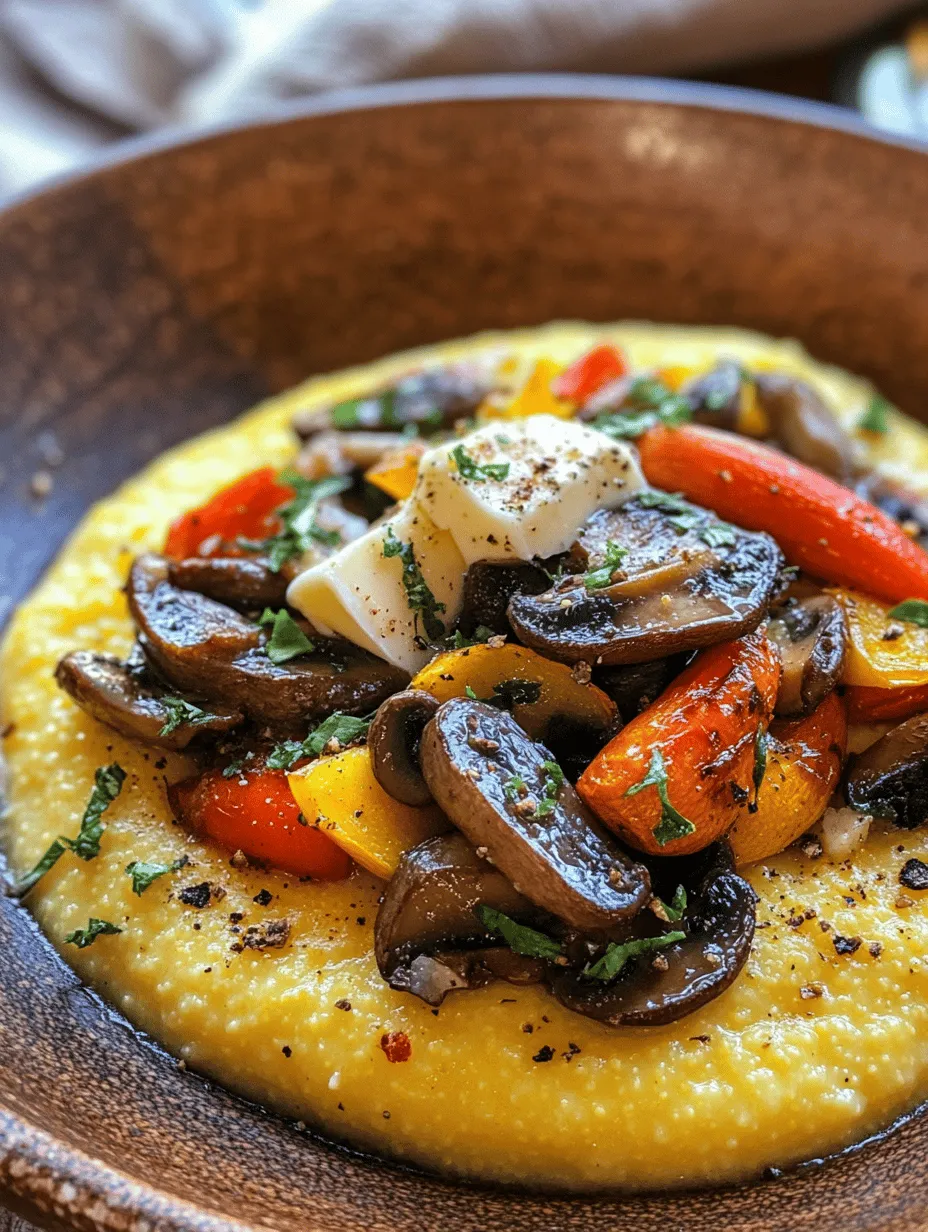Introduction
Welcome to the delightful world of Creamy Dreamy Polenta, a dish that embodies both comfort and versatility in every bite. Polenta, a staple in Italian cuisine, has gained global popularity not only for its rich, creamy texture but also for its ability to seamlessly adapt to a variety of flavors and culinary styles. Whether served as a comforting base for hearty stews or dressed up with gourmet toppings, creamy polenta holds a special place in the hearts of food lovers everywhere.
In this article, we will take you on a journey through the intricacies of making the perfect polenta, exploring its fascinating history and evolution over time. We will also highlight various serving suggestions that can elevate this humble dish into a gourmet delight. Get ready to embrace the creamy, dreamy experience that polenta has to offer!
Understanding Polenta: A Culinary Staple
The Origins of Polenta
Polenta has deep roots in the Italian culinary tradition, tracing its origins back to the early days of the Roman Empire. Initially made from farro or other grains, polenta began to be associated primarily with cornmeal in the 16th century after the introduction of maize to Europe from the Americas. The dish quickly became a staple in the northern regions of Italy, particularly in areas like Lombardy and Veneto.
Historically, polenta was viewed as a peasant food, often served as a filling meal for the working class. However, as culinary trends evolved, so did the perception of polenta. Today, it is celebrated as a versatile ingredient that can be transformed into a wide array of dishes, from simple comfort food to sophisticated gourmet creations. Chefs and home cooks alike have embraced polenta for its ability to absorb flavors and adapt to different dietary preferences.
What is Polenta?
At its core, polenta is a dish made from ground cornmeal, which is cooked in water or broth to create a creamy, smooth consistency. The type of cornmeal used can vary, with options including coarsely ground, finely ground, and even flavored variations. The choice of cornmeal can significantly impact the texture and flavor of the final dish, making it essential to select the right one for your creamy dreamy polenta.
Beyond its delightful taste, polenta offers numerous nutritional benefits. It is naturally gluten-free, making it an excellent option for those with gluten sensitivities or celiac disease. Polenta is also a good source of carbohydrates, providing energy, and it contains essential vitamins and minerals, including vitamin A, calcium, and iron. Furthermore, polenta can be an excellent base for incorporating additional nutrients through toppings and mix-ins, making it a versatile addition to any diet.
Ingredients Breakdown: What Makes Creamy Dreamy Polenta?
Essential Ingredients
To create the perfect Creamy Dreamy Polenta, you will need a few core ingredients that come together to form a rich and flavorful base. Here’s a closer look at what you’ll need:
1. Cornmeal: The star ingredient of polenta, cornmeal is the ground form of corn and comes in various coarseness levels. For creamy polenta, finely ground cornmeal is usually preferred, as it yields a smoother texture.
2. Water or Broth: The cooking liquid is crucial for achieving the desired consistency of your polenta. While water is a common choice, using vegetable or chicken broth can add extra flavor, enhancing the overall taste of the dish.
3. Salt: A pinch of salt is essential to enhance the natural flavors of the polenta. It helps to bring out the sweetness of the corn and balances the richness of the dish.
4. Butter or Olive Oil: Incorporating butter or olive oil into your polenta not only adds a luxurious creaminess but also enriches the flavor. The choice between butter and olive oil can also impart a different character to the dish—rich and decadent with butter or light and fruity with olive oil.
5. Cheese or Nutritional Yeast: For added flavor, many recipes call for cheese, such as Parmesan or Pecorino, which melts beautifully into the polenta, creating a deliciously creamy texture. For a vegan alternative, nutritional yeast can provide a cheesy flavor without the dairy.
Optional Ingredients and Toppings
While the essential ingredients create a delightful base, the beauty of creamy polenta lies in its adaptability. You can customize your dish with a variety of optional ingredients and toppings to suit your taste preferences and dietary needs:
– Sautéed Mushrooms: Adding sautéed mushrooms brings an earthy flavor and a meaty texture to the dish, making it even more satisfying.
– Roasted Vegetables: Seasonal roasted vegetables can add color, taste, and nutrients to your polenta. Try bell peppers, zucchini, or asparagus for a fresh twist.
– Fresh Herbs: Finely chopped herbs like basil, parsley, or chives can brighten the dish and add a burst of flavor.
– Sauces: Whether it’s a rich tomato sauce, a drizzle of balsamic reduction, or a savory mushroom gravy, sauces can elevate your polenta to new heights.
– Dietary Adjustments: For those following a vegan diet, consider using vegetable broth, olive oil, and nutritional yeast as substitutes. You can also explore gluten-free variations by ensuring your cornmeal is certified gluten-free.
Step-by-Step Guide to Making Creamy Dreamy Polenta
Preparation Overview
Now that we have a solid understanding of polenta and its ingredients, let’s dive into the step-by-step process of making Creamy Dreamy Polenta. This cooking method is straightforward and requires minimal equipment, making it accessible for both novice cooks and seasoned chefs.
1. Gather Your Ingredients: Start by measuring out your cornmeal, water or broth, salt, butter or olive oil, and cheese or nutritional yeast. Having everything prepared in advance will streamline the cooking process.
2. Boil the Liquid: In a medium saucepan, bring the water or broth to a gentle boil over medium heat. Adding salt at this stage will infuse the cooking liquid with flavor.
3. Whisking for Smoothness: As the liquid heats, gradually add the cornmeal to the boiling water while continuously whisking. This step is crucial for preventing lumps from forming.
4. Cooking the Polenta: Once all the cornmeal is added, reduce the heat to low and continue to cook the polenta, stirring frequently with a wooden spoon or a whisk. This will ensure a creamy and smooth texture as the polenta thickens. The cooking time typically ranges from 30 to 45 minutes, depending on the coarseness of your cornmeal.
5. Finishing Touches: Once the polenta has reached your desired consistency, remove it from the heat and stir in butter or olive oil along with the cheese or nutritional yeast. This will enrich the flavor and enhance the creamy texture that makes this dish so irresistible.
6. Serving Suggestions: At this point, your creamy dreamy polenta is ready to be served! You can enjoy it immediately as a comforting side dish, or pour it into a greased baking dish to set and slice later.
By following these steps, you’ll be well on your way to creating a delicious and satisfying plate of creamy dreamy polenta that can be paired with countless toppings and accompaniments, making it a truly versatile dish for any meal.
Stay tuned for the next part of this article, where we will explore tips for achieving the perfect polenta, along with common questions and troubleshooting advice to ensure your cooking experience is a success!

Cooking Instructions
To create the perfect Creamy Dreamy Polenta, start by gathering your ingredients and following these detailed steps for a smooth and creamy result.
1. Boil the Liquid: In a large saucepan, bring 4 cups of water (or a combination of water and vegetable broth for added flavor) to a rolling boil. Adding salt at this stage is crucial; use about 1 teaspoon to enhance the flavor of the polenta.
2. Add the Polenta: Gradually whisk in 1 cup of polenta (coarse cornmeal) to the boiling liquid. Whisking continuously will help prevent lumps from forming. This is a vital step, as incorporating the polenta slowly ensures an even texture.
3. Reduce to Simmer: Once the polenta is added, reduce the heat to low, allowing it to simmer gently. Continue to whisk for about 2-3 minutes until the mixture begins to thicken.
4. Cook the Polenta: After the initial thickening, cover the pot with a lid, leaving it slightly ajar to allow steam to escape. Let the polenta cook for about 30-40 minutes, stirring every 5-10 minutes. This stirring is essential to keep the polenta from sticking to the bottom of the pan and to achieve that creamy consistency.
5. Add Creaminess: Once the polenta is cooked to your desired consistency, remove it from the heat, and stir in 1/2 cup of heavy cream (or a dairy-free alternative for vegan options) and 1/2 cup of grated Parmesan cheese (or nutritional yeast for a vegan version). Stir until fully incorporated. Taste and adjust seasoning with more salt or pepper if needed.
6. Final Consistency: The polenta should be creamy and flow easily off the spoon. If it’s too thick, you can add a splash more of water or broth to loosen it up before serving.
7. Serve Immediately: Polenta is best served right away while it’s warm and creamy. Use a spatula to transfer it onto plates or into bowls, and be ready to add your favorite toppings.
Tips for Achieving the Perfect Consistency
– Use Quality Polenta: Opt for high-quality, stone-ground polenta, which tends to yield a creamier texture than instant or pre-cooked varieties.
– Whisk Constantly: Incorporating the polenta into the boiling liquid with a whisk helps break down any clumps that might form during cooking.
– Control the Heat: Cooking over low heat is essential for preventing the polenta from burning and sticking to the bottom of the pan. A gentle simmer allows for even cooking.
– Adjust Liquids as Needed: Depending on the type of polenta and personal preference, you may need to adjust the liquid quantities. If you prefer a thinner polenta, add more water or broth gradually.
Common Mistakes to Avoid
1. Skipping the Whisking: Failing to whisk the polenta in gradually can lead to lumps. Always whisk continuously when adding polenta to boiling liquid.
2. Using Too High Heat: Cooking polenta on high heat can cause it to scorch at the bottom. Keep the heat low for a gentle cooking process.
3. Not Stirring Enough: Polenta requires frequent stirring to maintain a smooth texture, so don’t neglect this step, especially in the first half of cooking.
4. Overcooking: While polenta can be forgiving, overcooking it can lead to a gummy texture. Follow the recommended cooking time and check for doneness periodically.
5. Neglecting Seasoning: Be sure to season the polenta adequately during cooking. Taste and adjust with salt and pepper to enhance the overall flavor.
Serving Suggestions: Elevate Your Polenta Dish
Polenta is a versatile dish that can be served in many ways. Here are some creative topping ideas and suggestions for pairing:
Creative Topping Ideas
– Sautéed Mushrooms: A delicious combination of sautéed mushrooms with garlic and fresh herbs creates a rich, earthy topping. Simply heat olive oil in a skillet, add sliced mushrooms, and cook until golden brown before seasoning with salt, pepper, and thyme.
– Roasted Vegetables: Roasting seasonal vegetables like zucchini, bell peppers, and cherry tomatoes brings out their natural sweetness. Toss them with olive oil, salt, and herbs, then roast in a preheated oven at 400°F (200°C) until tender and caramelized.
– Pesto Drizzle: A vibrant drizzle of homemade or store-bought pesto can add a burst of flavor and color to the creamy polenta. The herbaceous notes of basil or arugula pesto complement the corn’s sweetness beautifully.
– Cheese Variations: Sprinkle crumbled feta, goat cheese, or even blue cheese over the top for an added layer of flavor. The creaminess of these cheeses balances well with the polenta.
Polenta as a Base for Main Dishes
Polenta can also serve as an excellent base for hearty main dishes. Here are some ideas:
– Savory Stews: Serve polenta topped with a robust vegetable stew or ragu. The creaminess of the polenta pairs well with the richness of a tomato-based sauce or a lentil stew.
– Braised Meats: For a comforting meal, serve polenta alongside braised meats like beef short ribs or chicken thighs. The polenta absorbs the flavorful juices, making each bite divine.
– Vegetarian Chili: A hearty vegetarian chili with beans, peppers, and spices makes for a warming dish that complements the smooth texture of polenta perfectly.
– Grilled Proteins: Top your creamy polenta with grilled chicken, fish, or tofu marinated in a zesty sauce. The contrast of textures adds a delightful element to the dish.
Nutritional Insights: Why Choose Polenta?
Polenta is not only a comforting dish but also comes with a variety of nutritional benefits:
Health Benefits of Polenta
– Nutritional Values: Polenta is rich in carbohydrates, providing a good source of energy. A one-cup serving contains approximately 70 calories and is low in fat, making it a great option for those watching their calorie intake.
– Gluten-Free and Vegan-Friendly: Being made from corn, polenta is naturally gluten-free and suitable for those following a vegan diet. It’s an excellent alternative to wheat-based grains, making it accessible for various dietary restrictions.
Balancing Polenta with Other Ingredients
For a well-rounded meal, consider incorporating proteins and greens alongside your polenta. Here are some suggestions:
– Add Protein: Include a source of protein, such as grilled chicken, sautéed shrimp, or chickpeas, to enhance the nutritional profile and create a more filling dish.
– Include Vegetables: Incorporate a variety of colorful vegetables—spinach, kale, or roasted root vegetables not only add nutrients but also create a visually appealing plate.
– Healthy Fats: Drizzling with olive oil or adding nuts and seeds can provide healthy fats, promoting satiety and flavor.
Conclusion
Creamy Dreamy Polenta is a dish that embodies comfort and versatility. Its creamy texture and subtle flavor make it a perfect canvas for a myriad of toppings, allowing for endless culinary creativity. As a staple in many households, polenta invites experimentation with flavors from different cuisines, whether it’s the earthy notes of sautéed mushrooms or the fresh vibrancy of roasted vegetables.
Understanding the intricacies of preparing polenta not only enhances your cooking skills but also opens up a world of possibilities. By mastering this recipe, you can enjoy a delightful culinary experience that pays homage to tradition while embracing modern flavors. Whether you’re serving it as a side, a main course, or a base for your favorite dishes, polenta remains a beloved staple that satisfies diverse palates and dietary needs. Enjoy the journey of creating and savoring this classic dish!



